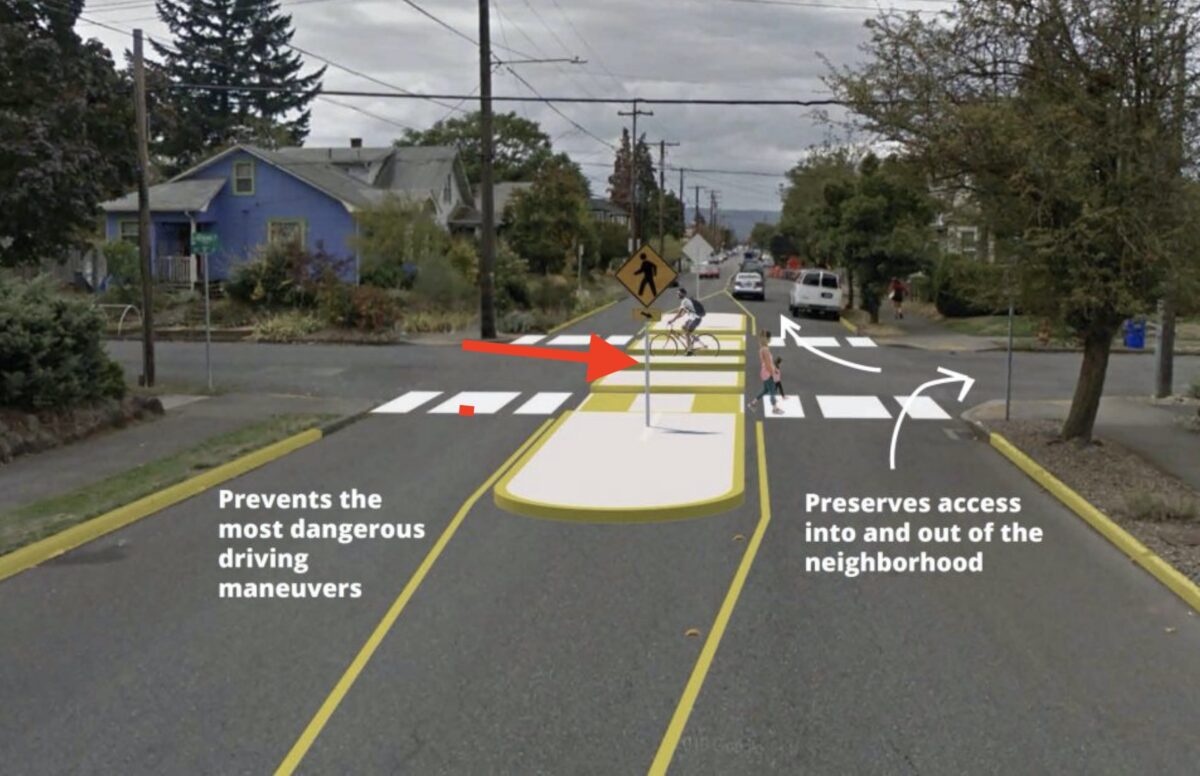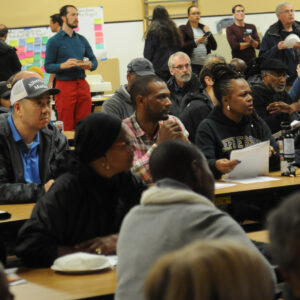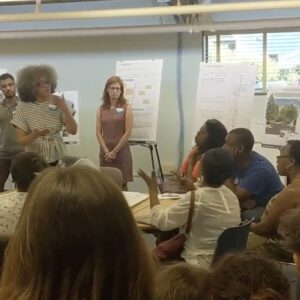
“The response to the diverter idea demonstrated a clear lack of community support for this type of traffic pattern change.”
— PBOT statement
After politely asking King neighborhood residents if they would voluntarily reduce driving access on Northeast 9th to make the street a more “low-stress, family-friendly” neighborhood greenway, the Portland Bureau of Transportation has announced that they won’t install a traffic diverter.
The crossing at Killingsworth is a key part of making the route on 9th safer and has already undergone an upgrade as part of Safe Routes to School project. PBOT felt an additional median in the middle of the intersection was needed in order to reduce the amount of drivers on 9th to volumes within acceptable limits. But loud voices from nearby residents — some of whom have suffered from decades of systemic racism at the hands of official city decisions and policies — drowned out PBOT’s proposal at a meeting last month.
“PBOT will not be installing a traffic diverter at the crossing of NE 9th and Killingsworth as a part of this project,” read a PBOT project email. “This area faces unique challenges in connectivity and circulation, as well as a history of damaging effects of transportation infrastructure projects. The response to the diverter idea demonstrated a clear lack of community support for this type of traffic pattern change.”
Advertisement
At the public meeting in October, the people who spoke up were almost all in opposition to the diverter. However, according to a voting exercise at the meeting, there was a significant (yet silent) number of people who supported it. PBOT also accepted feedback on the idea via an online survey (we haven’t seen the results of that).
PBOT says that although the diverter is off the table now, they plan to monitor the intersection to see how other changes on 9th impact driving behaviors. “Any future changes to traffic patterns will be made in partnership with the community and neighborhood association,” PBOT said.
In their Neighborhood Greenways Assessment Reported adopted by city council in 2015, PBOT established a target automobile volume of 1,000 average daily traffic (ADT), with 1,500 acceptable and 2,000 ADT maximum. According to PBOT’s ADT map, it appears 9th at Killingsworth is well over the target threshold.
Without this diverter, we’ll have to hope PBOT’s signage and speed bumps will be enough to reduce driving trips and slow people down to safe levels.
Below is the final design for the 9th Avenue Neighborhood Greenway:
For more on this diverter and how some people in the neighborhood feel about it, see our recap from the October meeting.
— Jonathan Maus: (503) 706-8804, @jonathan_maus on Twitter and jonathan@bikeportland.org
— Get our headlines delivered to your inbox.
— Support this independent community media outlet with a one-time contribution or monthly subscription.










Thanks for reading.
BikePortland has served this community with independent community journalism since 2005. We rely on subscriptions from readers like you to survive. Your financial support is vital in keeping this valuable resource alive and well.
Please subscribe today to strengthen and expand our work.
You win some and you lose some – don’t let perfect get in the way of good. The overall effect will likely be an improvement in bicycle and pedestrian safety on 9th. When the neighbors eventually change their minds – and they will – the median can be modified then.
Greenways without diverters are not near as enjoyable to ride as those with. As a cyclist who rides daily my experience on greenways is that almost every time there is as least one incidence of a car that makes me feel uncomfortable and unsafe by either “tailgating”, passing to close, or passing at speed. The only reason not to have a diverter is for the convenience of automobile drivers, and it just continues decades of policy emphasizing cars over safe streets. We will not be enticing more cyclists onto the streets until they can feel safe.
This greenway project has turned into an absolute joke. Cars will be flocking to 9th with no diverters and fewer stop signs than other neighborhood streets.
Is this a victory for those who have suffered from decades of systemic racism at the hands of official city decisions and policies?
A greenway diverter is pretty much the exact opposite of tearing down houses and ramming a freeway through a neighborhood. There is also a long history of PBOT favoring private motor vehicle use at the expense of all vulnerable road users. Why doesn’t that factor in to these decisions?
I don’t comment lightly. I know there have been and continue to be gross injustices done to people of color. I don’t equate systemic racism with our culture’s worship of the automobile, though parallels can be inferred.
As an aside, this is just a small scale example of the push back that lies ahead if anyone dares to ask the public to curtail their driving habits in order to reduce traffic deaths or try to slow the runaway disaster that is global climate change. We are well and truly screwed.
I have a similar dilemma that I have to face on a monthly basis. I serve on my local transit commission where we effectively manage a $22 million municipal transit system. Our budget is more or less fixed, we have shrinking bus ridership and constantly rising paratransit ridership. My dilemma is do we use our very limited funds to keep propping up our unsustainable paratransit service, which serves our highly-vulnerable disabled community of mixed race and mixed income, or do we expand our fixed-route bus service in which 90% of our riders are black and very poor, so that they may get to family-wage jobs that we don’t yet connect to? Meanwhile, our city annually spends 8 times our budget supporting car-oriented programs, facilities, and construction, which serves the rich and middle-class of all races.
Exactly, race of the community is I think an over-hyped aspect of this push back and explanation for the decision. It comes down to driving access and NIMBY’s, no matter their demographic, fighting it. What is notable is that now the City if giving into a community of color the way they at least used to with white areas, so… some equality coming around there but overall just a huge miss here.
As well as people who moved in long after the fact.
Why is your first description of the neighbors as “loud” and “drowning out” PBOT?
Go back and read the coverage of the meeting: https://bikeportland.org/2019/10/18/city-asks-king-neighborhood-to-decide-on-greenway-diverter-306408
The neighbors were loud in voicing their criticism, and the loud voices clearly drowned out the quiet supporters of the diverter. It’s the kind of grandstanding you often see at community meetings, and apparently PBOT has rewarded the grandstanding. That’s the message many people will take away. If PBOT wanted to counter this message, they would release the survey results.
If you want to see the survey results, make a public records request.
Start here:
https://portlandor.govqa.us/WEBAPP/_rs/(S(dtqswau4xxacjlzt5h52brih))/SupportHome.aspx
“Go back and read the coverage of the meeting: https://bikeportland.org/2019/10/18/city-asks-king-neighborhood-to-decide-on-greenway-diverter-306408”
“The neighbors were loud in voicing their criticism, and the loud voices clearly drowned out the quiet supporters of the diverter. ”
I just re-read through Jonathan’s post and nowhere did he claim that there were “loud voices” that “clearly drowned out the quiet supporters of the diverter.”
Where does this characterization come from? Were you even there?
Because people against the diverter were yelling and being rude to city staff and IMO their voices effectively prevented other people from feeling like they could speak up.
Maus was there lady. He is reporting what he experienced first hand. But this wokeness in a nutshell folks. Do not trust your own senses, bend your understanding of your own experience to the will of the scolding, dogmatic mob.
Let’s not assume gender here.
I live less than a block from here, and I’d just like to reiterate that a diverter blocking north/south traffic here would be less than useless for making that intersection better for the greenway. The last thing that intersection needs is design that encourages faster traffic on Killingsworth.
The number of cars crossing Killingsworth at 9th is already minimal, the real impediment is that Killingsworth is much busier than it’s designed for and crossing it at 9th is only for the brave cyclists who are confident at judging vehicle speed and waiting for gaps in traffic. As an example, I have better luck getting people to stop for me in a crosswalk on *MLK* than I do on Killingsworth at 9th, and I do one or the other about 5 days a week. I’m hoping the upgraded median will at least improve that a little by letting people cross halfway at a time, but I’m not holding my breath.
That intersection needs a traffic light, plain and simple. This isn’t really a bikes-vs-cars infrastructure debate, the intersection of Killingsworth and 9th is terrible for both groups at the moment, and it’s because PBOT insists on letting drivers treat Killingsworth like it’s a high-speed arterial, despite it not having the appropriate infrastructure for one.
A median diverter like the one shown above would slow traffic, because they have to drive around it. Adding a rapid flash beacon to the median would make it even better.
I don’t think these do much to slow traffic (I could name a dozen examples), but it may make the crossings more visible, which is probably more important.
It’s starting to sound like that what you really need is not a median diverter, but a traffic circle or small roundabout, something that allows traffic, but also slows it down. Too bad 4-way traffic signals are so expensive in Portland.
I’d take a traffic circle any day, but I seriously doubt the nearby police station would go for it (they obviously enjoy being able to fly down Killingsworth in an emergency).
I want to preface this by saying that I don’t agree with this attitude myself, but this issue is why bike infrastructure is hard to sell in historically poor neighborhoods like N/NE: when it comes to obviously necessary infrastructure improvements like traffic signals it’s just “too expensive”, but money can be found for projects that appeal to people in richer neighborhoods, and when those projects come into contact with the areas that couldn’t get a stoplight where one is needed it leaves a bad taste in your mouth.
The concrete median portion is already in, they finished installing it about a week ago. It’s not a diverter for 9th though, just the two pedestrian islands with crosswalks – this current discussion was about whether to add a diverter as well.
So far I haven’t noticed a significant reduction in traffic speed, most drivers just swerve around it at the same speed they were going before. They’ve added explicit no-parking sections to the stretches leading to and from the intersection, so drivers have a nice long space to maintain speed and navigate around the median.
I also live in this area. The barriers slow down traffic in a way because they backup traffic. When a vehicle attempts to turn left on 9th at Killingsworth but has to wait for traffic, there no longer is room for the vehicles behind to move around them.
The goal of the diverter is to limit access from Killingsworth which would decrease the amount of traffic on 9th and make it a more pleasant greenway. And people in cars definitely cross here. 9th is a very popular route from Fremont to Ainsworth.
The diverter portion would not slow traffic any more than the refuge island ends would.
The Jerry Springer style of public engagement just creates divisions among neighbours. The loudest voices get a platform and the rest get turned off by the process and stay quiet or leave. It makes for good drama for news media but that’s about the only advantage.
I’ve noticed here in Vancouver, BC that the City no longer does this type of engagement.
They now do a variety of things. Meetings with stakeholders (community groups for different interests, businesses, etc.), then open houses with display boards and surveys. They do workshops where local people (and anyone else interested) work together to figure out concerns and suggest solutions. Designs go through a few stages where the city staff take all the input and work out designs. Things that will not work (because of the laws of physics or are unsafe) are not used and the reasons why they were not considered are explained in the next presentation package.
It’s a lot of extra work but the result is that people end up feeling included (because they are) and they end up being a supporter of the project instead of an opponent of it. The design is stronger and useful to more people and activities.
In recent years in politics there has been an encouragement of creating divisions among people. Even in a country with cultural and lifestyle homogeny this isn’t good but in a place like North America with so many different types of people and with the many lifestyle options that people can choose from it’s worse.
Why is PBOT taking opinion polls on street safety measures? Making safe streets where people don’t die every week is either the priority or it’s not. Why does local opinion even come into play for topics like this?
Safety is not a “yes” or “no” thing; it’s got an infinite number of gradations, each with a set of trade-offs against other things people in our society value. Finding the right balance of safety vs. other values is a social/political exercise, and who better to be involved than those most directly impacted?
When someone is killed or seriously injured near this intersection in the future, do they get to retroactively assert their opinion as someone among “those most directly impacted” like we see in those instances when a long-known street safety issue is finally addressed after someone is killed? This is not a Vision Zero approach to street safety.
You’re falling back on the safe/unsafe binary, but I fundamentally agree with you. Perhaps if more people had been willing to speak up, the outcome would be different.